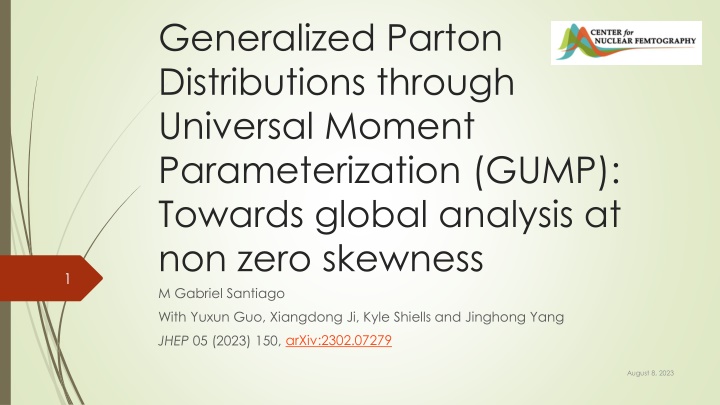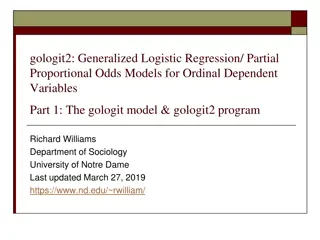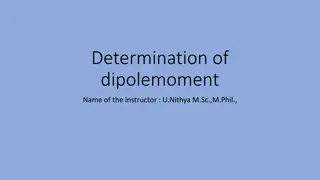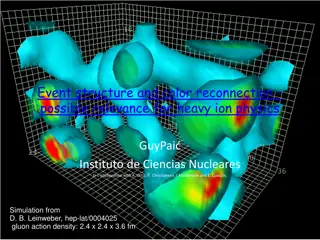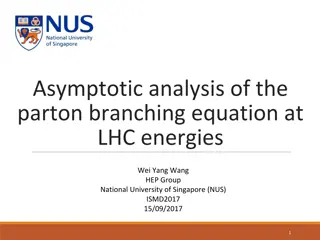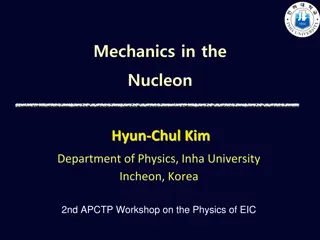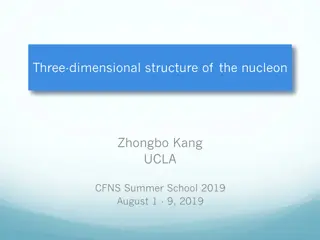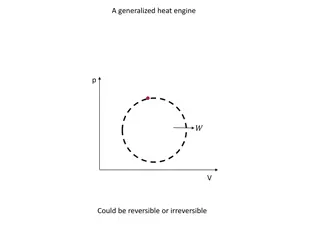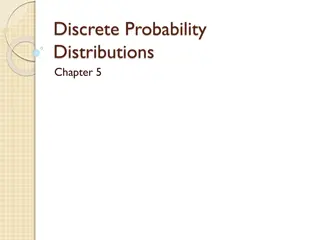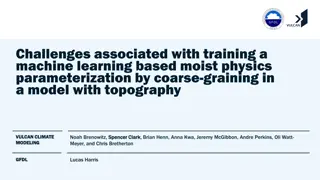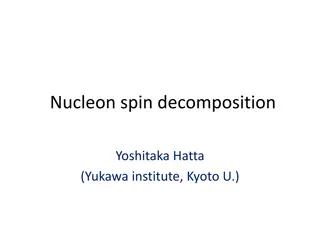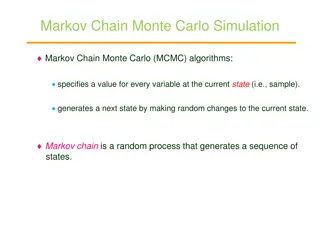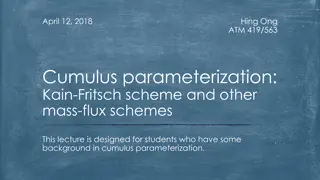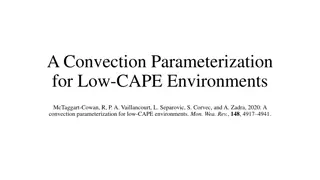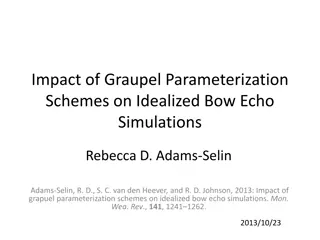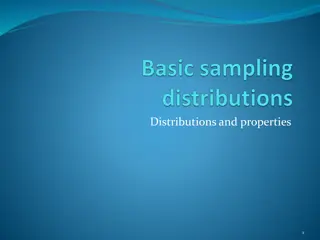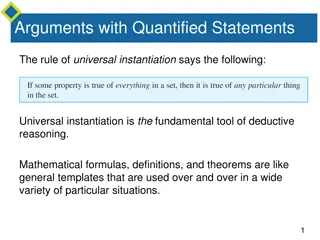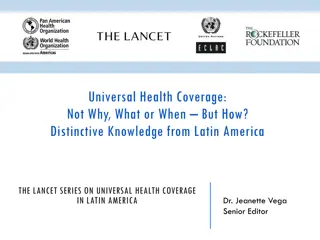Generalized Parton Distributions through Universal Moment Parameterization: Towards Global Analysis
This research focuses on the GUMP method for analyzing Generalized Parton Distributions at non-zero skewness. The study, led by M. Gabriel Santiago and team, utilizes universal moment parameterization to advance global analysis in high-energy physics.
Download Presentation

Please find below an Image/Link to download the presentation.
The content on the website is provided AS IS for your information and personal use only. It may not be sold, licensed, or shared on other websites without obtaining consent from the author.If you encounter any issues during the download, it is possible that the publisher has removed the file from their server.
You are allowed to download the files provided on this website for personal or commercial use, subject to the condition that they are used lawfully. All files are the property of their respective owners.
The content on the website is provided AS IS for your information and personal use only. It may not be sold, licensed, or shared on other websites without obtaining consent from the author.
E N D
Presentation Transcript
Generalized Parton Distributions through Universal Moment Parameterization (GUMP): Towards global analysis at non zero skewness M Gabriel Santiago 1 With Yuxun Guo, Xiangdong Ji, Kyle Shiells and Jinghong Yang arXiv:2302.07279 JHEP 05 (2023) 150, August 8, 2023
Outline 2 GPD Review GUMP Program Conformal moment parameterization First Step Towards Global Analysis: u and d quarks Simplified GPD moment ansatz Experimental and lattice input Non-zero Skewness Global Fit GPD Extraction Ambiguity in the ERBL/DA-like region D-terms vs DA-like terms Moving Forward Conclusions August 8, 2023
GPDs 3 GPDs generalize the well known PDFs to encode full 3 dimensional information on the quarks and gluons within hadrons August 8, 2023
GPDs 4 Polarization of the hadron and its parton constituents connects GPDs to the distribution of angular momentum within hadrons (X. Ji 1997) Ji sum rule Related via a Fourier transform to the impact parameter distribution of partons (M. Burkardt 2003) Related to bulk properties of hadron states encoded in form factors August 8, 2023
GUMP program: Moment Parameterization 5 Parameterize GPDs by directly parameterizing their conformal moments (D. Mueller and A. Schafer 2006) Expansion based on eigenfunctions of evolution Gegenbauer polynomials conformal wave function GPD evolution kernel August 8, 2023
GUMP program: Moment Parameterization 6 Conformal moment parameterization has nice features for fitting GPDs Simple evolution implementation conformal moments are multiplicatively renormalized at LO Follows from using eigenfunctions of evolution kernel Polynomiality condition (X. Ji 1998) automatically enforced on conformal moments August 8, 2023
First Step Toward Global GPD Analysis 7 Apply in GUMP program for global analysis of u and d quark GPDs at non- zero skewness with LO scale evolution Parameterize each GPD moment with five parameters ? ? = ? ? ? Euler Beta Function Regge trajectory Take each moment to be a power series in skewness polynomiality condition August 8, 2023
First Step Toward Global GPD Analysis 8 The number of parameters needed for modelling all the species of GPD grows very quickly We impose extra constraints for simplicity August 8, 2023
Non-zero Skewness Global Fit 9 Even with constraints, lots of parameters! Very high dimensional space to navigate for best fit Very computationally demanding to do error propagation We employ a sequential fit, starting with forward (PDF, t-dependent PDF) constraints for each GPD species then apply the off-forward constraints from DVCS data August 8, 2023
Semi-Forward Inputs 10 JAM (2022) PDF global analysis results Full global analysis should in principle fit to PDF sensitive data directly, but here we fit to JAM results Limited number of points taken to avoid need for more sophisticated forward limit Globally extracted electromagnetic form factors (Z. Ye et al 2018) Lattice GPDs (Alexandrou et al 2020) and form factors (Alexandrou et al 2022) x,? -dependent GPDs (semi-forward limit) August 8, 2023
Off-Forward Inputs 11 DVCS measurements from JLab (CLAS 2019 & 2021, Hall A 2018 & 2022) and HERA (H1 2010) Only using ?-dependent cross sections due to practical limitations Far more points from JLab data than from HERA from ?-dependence and both UU and LU polarization channels Off-forward lattice GPDs not used in fitting, but can supply crucial constraints for future work! August 8, 2023
Non-zero Skewness Global Fit 12 Total ?2/dof is approximately 1.4 Some agreement with both JLAB and H1 data Gluon GPDs not well constrained at non-zero skewness Only contribute to DVCS through evolution at LO Error propagation is not yet implemented Very computationally expensive with so many parameters! August 8, 2023
Non-zero Skewness Global Fit 13 CFFs from fit are mostly consistent with local extraction from JLAB Hall A data as well as KM15 extractions Some inconsistencies can be expected from degeneracies in CFF contribution to cross sections need more polarization configurations! August 8, 2023
Extracted GPDs 14 GPDs are mostly constrained on the ? = ? line and in the DGLAP region |?| < |?| ERBL region shows large oscillations which are characteristic of the Gegenbauer polynomials used in the moment expansion August 8, 2023
Ambiguity in ERBL Region 15 We can add terms in the moment expansion which only contribute to the ERBL region This suggests an interpretation of the GPDs in terms of quark and antiquark pieces as well as a ERBL region distribution amplitude (DA) piece quark antiquark DA August 8, 2023
Connection to D-term 16 These DA terms don t have a large affect on CFFs, but they do contain information related to the various D-terms in QCD, ex. Gravitational form factor C/D Dispersion relation subtraction term By constraining the DA terms with further experimental data and lattice calculations, we can access the mechanical properties of hadrons contained in these D-terms! August 8, 2023
Constraining DA Terms 17 Adding in lattice GPD calculations can give us constrains directly in the ERBL region Adding just a few terms to the moment expansion can remove the unphysical oscillations August 8, 2023
Moving Forward: Adding in Gluons! 18 DVCS at LO is only sensitive to gluon GPDs through scale evolution Using Deeply Virtual Meson Production (DVMP) gives a direct probe of gluons at LO Light vector mesons have similar sensitivity to quarks and gluons KM framework applied to produce simultaneous fits of DVCS and DVMP for ?0 meson production with data from HERA (see Marija s talk on Wednesday) Add heavy vector meson to obtain better constraints on gluon GPDs use ?/? production! August 8, 2023
Deeply Virtual ?/? Production 19 Charm quark contribution for nucleon target is negligible direct probe of gluons Complementary with GUMP work on quark GPDs, but mostly sensitive to small-?? region whereas JLab data combined with HERA gives better constraint at moderate ?? Caveat: mass of the ?/? is too large for usual collinear factorization Need to take heavy mass corrections into account non-relativistic (NR) QCD! August 8, 2023
Non-relativistic model approach 20 Encoding the ?/? formation into NR matrix elements Maintain the form of the factorization theorem for the process still sensitive to leading twist GPDs (D. Y. Ivanov et al 2004) Systematically improvable with relativistic, higher twist, and NLO QCD corrections Bridge between electroproduction and photoproduction regimes August 8, 2023
Implementing NR ?/? Production in GUMP 21 LO framework used for previous global fit does not match data in HERA kinematics NLO evolution is known in moment space (Mueller et al 2013) NLO NR matrix element for ?/? formation is known (D. Y. Ivanov et al 2004) Finite mass corrections for hard scattering are only known in momentum fraction space Mass corrections make the convolutions for converting to conformal moment space much more complicated Adaptive numerical complex integral to construct GPD from moments is computationally expensive August 8, 2023
Implementing NR ?/? Production in GUMP 22 Implemented NLO evolution Corrections are large enough to fix scaling problems from LO! Switching over to a fixed order integral evaluation allows significant reduction in computation time with < 1% extra numerical error Terms in the integral can now be memorized and only calculated a few times (as in Gepard) Conversion of NLO finite mass hard scattering terms to moment space is on going August 8, 2023
Future Improvements/Additions 23 Implement ?/? electroproduction fits with NLO Add threshold ?/? production potentially constrain D-term/DA-terms Add quark flavors and implement ?0 and ? electroproduction Full simultaneous global analysis with DVCS and DVMP contributions Implement ?-integrated cross sections speed up for NLO could make t- integrated cross sections practical August 8, 2023
Conclusions 24 Global fit combining experimental data and lattice calculations to constrain GPDs at non-zero skewness Developing the GUMP program to include gluon GPDs in global analysis through ?/? production data Implementing NLO corrections Several directions for future improvements available August 8, 2023
25 Backup Slides August 8, 2023
Best Fit ?2 Breakdown 26 August 8, 2023
27 Best Fit Parameters August 8, 2023
